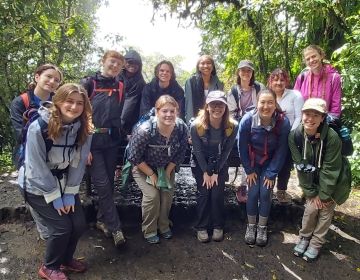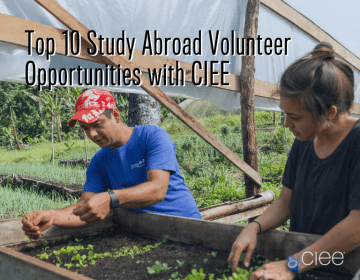Sustainability and the Environment: "Invade the Block!"
I bet you're thinking that this whole semester has been tragically lacking in studies on invasive species, aren't you? Well I would first respond by telling you to scroll back and check out the "Morning Walkabout" freshwater ecology post, because we totally talked about some invasives then. But after you did that, I would tell you not to worry, because Thursday, February 25th, was Invasive Species Day!
We should probably start by defining invasive species, just in case you've forgotten. To understand invasive species, you first have to understand "exotic" species, which are basically just species that occur outside of their natural range. An "invasive" species, then, is an exotic species that establishes itself and increases in abundance at the expense of other species. It's important to note that only one percent of exotic species introductions lead to established populations capable of increasing and spreading, and it may take decades for them to become invasive.
Now, all that being said, that doesn't mean you should go release a lion in the Evergaldes or something. Try to use your head, people.
Adam started off the day with a little lecture, just to make sure all these kids were sure they knew what was going on. The first thing he wanted to talk about was how exotic species might be introduced-- either unintentionally (like in cases of hitchhikers on shoes, commercial transport, and seed jewellery), and intentionally (recreation, erosion control, ornamentals).
After the lecture was over, Adam handed out a couple examples of invasive species that he had picked up on his walk to work, and told the students to try to identify and learn a little bit about them, and once they had done that, they were going to go out on a little walkabout and let the adventurers teach each other.
Aislyn, Julia, and Morgan are getting their story straight before they present their species
While the adventurers are busy learning about their plants, we can learn some more about invasive species...
Adam also talked about the sort of things that can allow an exotic species to become invasive, like the number of founders, high fecundity (which means capacity for reproduction), dispersal ability, parthenogenic or hermaphroditic reproduction, broad physiological tolerances, broad diet, similarity of the new environment to the original habitat, and "enemy release."
Are you wondering about the impact of invasives on the new environment? I gotcha covered. Invasive species can cause population declines and even extinctions, and they can permanently alter a community. Introduced predators can take care of pests for a little while, but then they usually get hungry again once all the pests are gone and start eating all the other stuff too. For instance, the introduction of predatory nile perch into lake Victoria led directly and indirectly to the extinction of 200 to 400 species of endemic cichlids, which are super pretty fish. Or were anyway.
Invasives can have genetic and evolutionary impacts as well, especially in cases of hybridisation with native endangered species.
Meg is enjoying being a plant detective-- you know, a detective whose clients are plants
All this stuff is particularly interesting to these adventurers, because 56 of the top 100 most invasive species can be found in the tropics. Degraded habitats (like, you know, re-emerging secondary forest) have proven to be much more susceptible to invasion.
But before you start freaking out and running around like crazy, here are some methods to control invasive species: there's the chemical and mechanical method (pick them with your hands, or hunt or trap them), the biological control method (release native predators and diseases), and the preventative method (don't release your rhinos into Wisconsin.
Wow, that was a lot of learning, wasn't it? We'd better got outside with the adventurers to get a little fresh air in our brains. Adam took them walking down the road just a little ways beyond the study center, because he knew that they'd be able to find a ton of the invasive species they were studying just off the side of the road out here.
Aislyn, Morgan, and Julia decided to throw in a little mythology with their explanation
Yeah, so the photographer didn't know that Morgan's presentation of her species was going to be this good, so he only caught the second half on video. Basically she was explaining the mythology behind the White Butterfly Ginger Lily, and this mythology involved a deal with a witch, and something to do with the witch's mattress. The photographer will have to check back with Morgan sometime to get the full story. Here's the second half:
There's that stupid witch's plant
Only a few steps later, Adam spotted another invasive species, and it was time for Eilish, Chandler, and Dan to talk about their plant. Their presentation involved a lot fewer witches, but probably a few more facts.
Witches never messed with Eilish's plant
Then just a little farther down the road, Adam spotted another invasive species, called the Pinto Peanut apparently, which was awful convenient, because that was the plant that Emma, Hannah, Tessa, Amanda, and Rachel had been studying.
Emma, Hannah, Tessa, Amanda, and Rachel talk about the "Pinto Peanut"
This guy is native to South America, specifically Brazil, and it loves wet environments. It's super tolerant, to shade but also to pesticides, so it's really tough to eradicate. People originally planted it here as a cover crop, to keep the soil together and to try to keep other weeds out, but this little guy sure did take off and start growing all over the place.
Look at these tough little fellas
Dum de dum dum, down the road we go, and oh, what do we have here? It's another invasive species. Leah, Ian, Meg, and Sadia took the lead on this one. Their plant was called the Wandering Jew, which definitely means it was named before tact was invented. It was originally native to Mexico but has spread all over Central America and even into Asia, because people like to plant it as an ornamental. Dan admitted that he had some of this plant as a decoration in his apartment, which means it's all his fault probably.
Meg said, "It's very unique because there is no story."
It was a full morning of learning about invasive species in a pretty sweet environment. Once they'd talked about most of the ones the adventurers had been looking at, Adam took them on a little walk up the mountain to try to find some more.
So up they went on another little morning walkabout, on the hunt for invasive species. Whenever they found one, Meg would pull it out and carry it along with her; she was gonna end this whole invasive species problem in an afternoon.
At one point they had to jump across a little stream, and it turned out that Emma's luck from the water lab had decided to stick with her for a little bit.
The photographer learns he really needs to keep the camera on Emma when she crosses streams
A nice little lookout spot (and some product placement from Los Pinos lodge)
And that was Invasive Species Day! The adventurers made sure to enjoy their time up here in Monteverde, because they knew that in just a few days (three to be exact), they would load themselves onto a bus and head out on their first field trip, a two week adventure of touring power plants, mucking around in mangroves, and visiting a mysterious island.
Fair warning to all that follow the tales of these adventurers: they are journeying to a land that has not yet known the soft kiss of Wi-Fi and cell phone service, so these dispatches may fall a little bit behind, and their parents may not hear from them for several days at a time. But rest assured: they'll return just fine-- a little older, a little wiser, but all in one piece for sure.
They're adventurers, after all.
Related Posts

Happy Earth Day: Today and Every Day
Happy Earth Day! Every April 22, this global event comes around to remind us how precious our planet is, what sustainable efforts we can make to protect Earth, and that... keep reading

Costa Rica vs. Argentina: Which is Better for Study Abroad?
Imagine yourself sipping mate in a bustling Buenos Aires café or lounging peacefully in a hammock overlooking Costa Rica's lush rainforests. These contrasting scenes represent just a glimpse of the... keep reading

Top 10 Study Abroad Volunteer Opportunities with CIEE
Have you ever wondered if you could volunteer abroad? Perhaps you're looking into study abroad programs that provide international volunteer opportunities. If you’re itching to study abroad and truly make... keep reading
